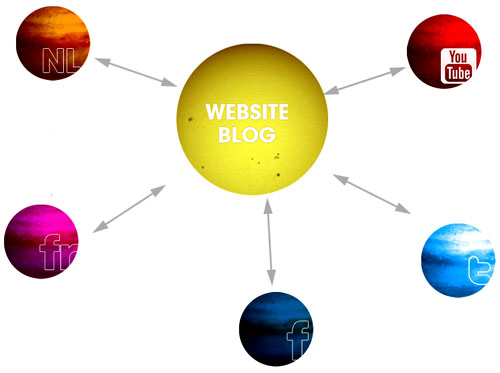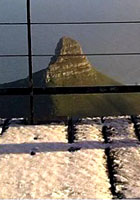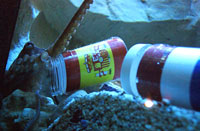Storytelling, social networking, destination marketing: selling tourism online
Whether you're a small guesthouse or a large hotel group, a single craft outlet or a large tourism NGO, a small town's destination marketing agency or a provincial or national organisation, you need to think carefully about how to use content strategically to grow your tourism business.
The better the online content you serve and the more widely it appeals, the more chance you have that your efforts on the web will ultimately translate into more feet through your doors, and perhaps, if that's what you're looking for, more revenue in your bank account.
Not formulaic
But storytelling for the web is not formulaic; it is complex and it's difficult to predict what will capture people's imaginations.
First, you need to think of the web and social media landscape broadly. Envision the web as a universe, with the Big Bang happening circa the 1980s. Twenty-five years on, this universe is quickly expanding, with millions, now billions, of websites appearing. Social networks are also expanding - there are currently roughly 300 major social networks in the world, including hundreds which you've probably never even heard of.
So let's just stick to our solar system for now. Take a look:

At the centre is your website, which should also contain a blog or a section that's easy to update quickly. Generally speaking, the static pages on your website will showcase content that is relatively timeless. Attractions are perennially good Google juice on a destination website.
If you're, say Cape Town Tourism, which is tasked with managing the destination marketing for the City of Cape Town, and also has thousands of members in the tourism industry, your static pages might include write-ups of attractions - anything from iconic destinations like Table Mountain and the Two Oceans Aquarium, to smaller, lesser-known attractions such as the Macassar sand dunes or the Willowbridge Slow Market.
In contrast, your blog should be the place where your content is constantly updated and dynamic, preferably changing as quickly as possible (once a day or more if you can, but there's also a good argument for quality over quantity).
Aim for a mixture of tried-and-tested static pages and riskier dynamic pages that present content which is highly timely.
Part of the reason your website is the sun of your online marketing solar system is that you own it (be careful that you do own it - there are some unscrupulous web companies out there!). Look after it and never neglect it.
So now we get to the planets in the social networking solar system.
- Planet Facebook
A Facebook fan page (more than a Facebook group - groups are quickly becoming outdated) can become a powerful planet with its own influential citizens, who can be mobilised/encouraged to consume - and contribute further to - content on your website/blog.
With almost 150 000 fans, Cape Town Tourism's Facebook fan page is its most powerful planet. Many of Planet Facebook's citizens in this case don't live in Cape Town or even in South Africa. Facebook is great to organise events, to conduct quick polls, and to encourage people to participate in three key phases of their journey to their destination - the dream, plan and remember phases.
You can also promote competitions on Facebook, but be careful about how you do this or risk it getting shut down - the terms and conditions of doing this run to pages long. Remember, though, Facebook owns your Facebook fan page; you don't. Don't put everything into Facebook and forget about your actual website.
- Planet Flickr
Flickr is a social networking site that revolves around sharing pictures. To date, more than four billion images have been uploaded to Flickr. In South Africa, it's still fairly niche, but its users are most often passionate photographers, who want to share their photos.
Creating a Flickr group is a great way of harnessing interest in and loyalty to a destination online, and running photo competitions on Flickr can be useful for sourcing relevant, beautiful photographs. The rapid global expansion of Creative Commons (a free copyright movement, in which people give away their content for free, as long as they are attributed) has made it relatively easy to source high quality images at no cost other than your time.
We often see visitors who come to our websites via Flickr (ie they've joined a group, then gone to visit the website publicised in it) stay longer and visit more pages than do visitors off other referring websites, so Flickr users are more engaged than the average user.
- Planet YouTube
Now the world's second-largest search engine after Google, YouTube is an increasingly powerful social networking planet. If you haven't already, buy a simple video camera (flip videos are great), start a YouTube channel (no cost), and start putting as many videos as possible (kindly hosted and advertised for free by YouTube) into your blog posts.
A few thousand people might read a single blog post on a South African tourism site, but up to millions will watch a good video. Take a look at Battle of the Kruger, for instance, which now has over 56 million views on YouTube. This video is arguably the best marketing the Kruger National Park has ever had, and it was free!
- Planet Twitter
Twitter is where you headline your blog post. As soon as you've posted something, tweet it. Make sure there's functionality on your blog for others to tweet and 'like' posts. This can help make your post go "viral", as others see what their friends are recommending. Other people saying your post is worth reading has much more impact than you saying that yourself.
- Planet e-newsletters
If your website has a pull-factor, attractive and well-executed e-newsletters can have a strong push factor. They land in someone's inbox, and push people to click through to your site. Time your newsletters well - we've found that in South Africa, the best time to send them out is on a Tuesday, Wednesday or Thursday morning, at around 6am (before people start arriving at work).
The idea is to repackage some of the best content from your website and blog, and perhaps provide some new content. Over time, you can segment and grow your e-newsletter databases into powerful brand-awareness and selling machines.
Let's return to the sun, your website, for a moment. The strength of its gravitational pull on all the other planets is defined by the quality of the storytelling contained in it. It's worth remembering the journalistic values of newsworthiness when compiling your content.
Newsworthiness
Stories will be most attractive to readers if they can harness a combination of the following elements of newsworthiness:
- timeliness (when something happens - the present, immediate future and immediate past are most powerful. Lesson: get your post up yesterday!)
- prominence (refers to someone famous or a powerful brand)
- novelty (something very unusual, eg snow on Table Mountain)
- proximity (where the story appeals; this can expand or contract, depending on the story and what other elements it harnesses. Capetonians will be most interested in a blog post about upcoming events in Cape Town this weekend; thousands of people around the world will be interested in the pictures of Halle Berry filming in Simon's Town.)
- impact (the number of people your story appeals to)
- money (if something costs a lot, people will generally be interested, especially if public money is spent)
- sex and scandal (like money, probably not an element of newsworthiness many tourism businesses would be keen to play up)
- conflict/violence (again, not an element to focus on for marketing your destination, but be aware of its power. If the mayor of Cape Town and a local tour operator came to blows, it would be newsworthy.)
In the old days, journalists wrote stories containing the above elements of newsworthiness. These days they still do, but savvy online content editors also trawl their online and offline networks to showcase user-generated content (UGC), or social media content that has already been created by ordinary people.
People love to share good stories that have happened to them; people love to tell others stories, and people love to listen to good stories. The web is making storytelling, which has been an age-old social past-time since our ancestors first sat around fires hundreds of thousands of years ago, slicker and better and easier than ever before.

Whale of a tale
Ralph Mothes and Paloma Werner from the Cape Town Sailing Academy were lucky to escape death when a southern right whale jumped out of the water and landed right on top of their yacht just off Cape Town in July 2010. People on other boats close by took photos and video of the event. Someone even sold a video to CNN.
Cape Town Tourism ran a couple of blogs on the story (timeliness, novelty, proximity) just after it happened. We sourced the pictures from the Portfolio Collection's blog, which beat us in timeliness in getting it up, but our post nevertheless attracted hundreds of views within a few days (watch a video of the event).
This wasn't nearly as good as Russia Today (notice expanded proximity), which did a quick slideshow and interview with Mothes, and has now received close to one million views on YouTube.
Pass the buck. Then kill it.
This is a story not for sensitive viewers. Jaci's Lodges ranger, Neil Steedman, took a video of a pack of wild dogs killing a kudu in the Madikwe Game Reserve (violence/conflict, novelty). He put it on YouTube and it attracted over 100 000 views, so he could guess there was a certain mass appeal to the story. He then wrote a blog on the newly launched www.madikwe.com last week, entitled "Would you really want to see a kill?", asking potential visitors to Madikwe (thus catching them in the dream/plan phase) to reflect on their personal potential reaction to watching a kill in the wild - an act of nature, but nevertheless very gruesome.
Yes, this is dicing with the highly controversial, but hundreds of people have already read Steedman's blog post. Perhaps one or two will ultimately land up at Jaci's Lodges, which they may never even have heard of before.
Spread your tentacles
At the height of Paul the Octopus's 2010 FIFA World Cup result-predicting powers, the Two Oceans Aquarium announced the existence - and similar prediction abilities - of Jabulani, its resident octopus (timeliness, novelty, proximity). Jabulani single-tentacled attracted more than 3000 visits to www.aquarium.co.za in July 2010, around a quarter of monthly traffic to the site at the time.
More pleasing for the Two Oceans Aquarium, Cape Talk held a news conference on site, to record Jabulani's final prediction. This in turn was followed by some of the busiest days in July in the aquarium's history.

It really does snow in Cape Town
On Tuesday, 15 June 2010, the Table Mountain cableway staff were surprised and delighted to see a dusting of snow on top of Table Mountain when they alighted from the morning's first cable car. They snapped a few photos, published a quick blog post on www.tablemountain.net, and their pictures attracted thousands of views, over 100 Facebook likes, and several nice comments from people saying they couldn't wait to come to Cape Town and go up Table Mountain (dream, plan).
Fossils rock!
When the discovery of an exciting new hominid species, Australopithecus sediba, was announced in April this year, Maropeng, the official visitors' centre of the Cradle of Humankind, was poised to capitalise on the excitement.
First, Maropeng ensured that the announcement would take place on its premises (proximity). Next, the who's who of the palaeoanthropological community, academia, government and the media were invited (prominence). Excitement built as secrecy about what would actually be announced was strictly maintained. Eventually, we discovered that this new species could have been ancestral to all of us (impact).
Maropeng's website, www.maropeng.co.za, was packed with good, in-depth stories exploiting several angles. Local media covered the story extensively, and it even made it onto the front page of The New York Times, with a link back to Maropeng's site as the most authoritative local site. This single link alone resulted in thousands of visits to the website.
Maropeng's (offline) visitor traffic has grown significantly every single month since the sediba discoveries were announced, when compared to the same months in past years.
Yes, there was plenty of traditional media coverage of this announcement, too, but it's probably safe to say that the online coverage did its fair share to encourage people to actually make the trip to Maropeng to see sediba.How to get a story out
I've recounted a few winning destination-marketing stories. But how do you get a good story out to the universe?
First, you need to ensure your social networking planets exist. Depending on your story, your process should be something like this (all done as quickly as possible):
- Put pics on/choose pics from Flickr
- Put video on YouTube
- Write blog post (or get guest to, but must be super-quick)
- Tweet it
- Post it to Facebook
- Include it in your next newsletter
Of course, you often don't know what will capture people's imagination. So you've got to repeat this process over and over and over and over. The more consistently and better you do it, the more you will build your web traffic, and hopefully your real-life visitors.
And finally, trust in the power of good storytelling. Be cautious of selling anything too hard: tell great stories and win your customers over with more show than sell.
Tara Turkington will be presenting on the power of storytelling in building an online business at the E-Tourism Africa Conference at the Cape Town International Conference Centre tomorrow, Tuesday 26 October 2010, at 10am.
About Tara Turkington
View my profile and articles...
